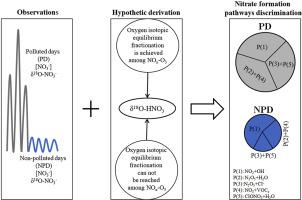当前位置:
X-MOL 学术
›
Environ. Pollut.
›
论文详情
Our official English website, www.x-mol.net, welcomes your feedback! (Note: you will need to create a separate account there.)
Stable oxygen isotope constraints on nitrate formation in Beijing in springtime.
Environmental Pollution ( IF 8.9 ) Pub Date : 2020-04-04 , DOI: 10.1016/j.envpol.2020.114515 Li Luo 1 , ShuhJi Kao 2 , YunFei Wu 3 , XiaoLing Zhang 4 , Hua Lin 5 , RenJian Zhang 3 , HuaYun Xiao 6
Environmental Pollution ( IF 8.9 ) Pub Date : 2020-04-04 , DOI: 10.1016/j.envpol.2020.114515 Li Luo 1 , ShuhJi Kao 2 , YunFei Wu 3 , XiaoLing Zhang 4 , Hua Lin 5 , RenJian Zhang 3 , HuaYun Xiao 6
Affiliation

|
Rapid accumulation of aerosol nitrate (NO3-) contributes to haze pollution; however, studies quantifying NO3- formation mechanisms remain scarce. To explore aerosol nitrate formation pathways, total suspended particulate (TSP) samples were collected in Beijing during the spring of 2013, and the concentration of NO3- and δ18O- NO3- value were analyzed. The NO3- concentrations on polluted days (PD) were higher than those on non-polluted days (NPD). Furthermore, higher δ18O- NO3- values were observed on PD (86.8 ± 8.1‰) as compared with NPD (73.7 ± 11.0‰) suggest that more nitrate was produced by pathways with relative high δ18O-HNO3 values during PD. Based on the calculated δ18O-HNO3 values from different formation pathways and the observed δ18O- NO3- values, the possible fractional contributions of HNO3 formed via various pathways to TSP NO3- were estimated using the Bayesian isotope mixing model. The δ18O- NO3- constrained calculations suggest that the pathways of N2O5 + H2O/Cl-, NO3 + VOCs, and ClNO3 + H2O possibly contributed 53%-89% to nitrate production during PD. During NPD, the NO2 + OH pathway produced 37%-69% of the NO3-. Using the δ18O- NO3- value combined with the isotope mixing model is a promising approach for exploring NO3- formation pathways.
更新日期:2020-04-20



























 京公网安备 11010802027423号
京公网安备 11010802027423号